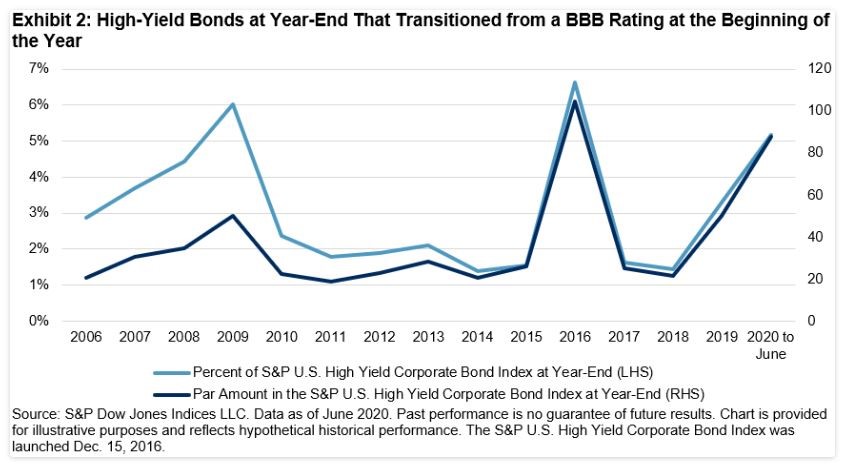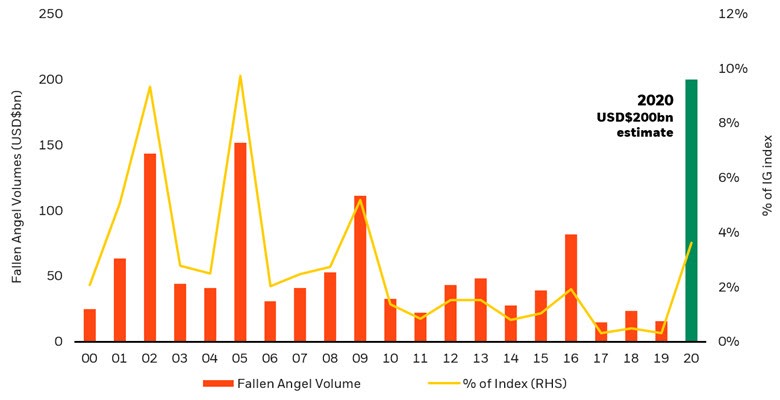After growing rapidly over the past 10-15 years, high-yield bonds now comprise roughly 15% of the overall corporate (investment-grade) bond market, which is estimated at roughly $8.1 trillion, notes Bryan Perry, editor of Dividend Investing Weekly.
The appetite for yield coming into 2020 was running high, even as the junk default rate rose to 3.3% in 2019, the highest level in three years and well above the non-recession norm of 2.4%, according to Fitch Ratings. Those defaults amounted to $38.6 billion, a 32% surge from 2018.
What is more concerning is that the share of BBB bonds that were downgraded to below an investment-grade rating has been on the rise since 2019. These fallen angel bonds from the BBB rating have supplied $88 billion of supply to the high-yield bond universe so far this year.

According to Citigroup, U.S. credit-ratings firms have downgraded $144 billion of bonds from investment-grade to junk, with some projecting at least $200 billion total over the course of 2020.
The bigger number being reported by Citi implies that billions of bonds dropped from A or higher ratings straight to junk status. This meant that they bypassed a BBB rating altogether.
While the stabilizing forces of the Fed have supported and led a rebound in high-yield prices, BlackRock has noted that some longer-term fallen angel projections are as high as $700 billion — and BlackRock is the Fed’s primary corporate bond broker. Most of these dire predictions occurred before June, when conditions were looking pretty bleak.
History shows that fallen angel spread-widening typically occurs well ahead of any rating downgrades. So, investors who are invested in high-yield bonds should pay close attention to this potential canary-in-the-coal-mine scenario.
The current market sentiment believes that “Quantitative Easing (QE) Forever” will provide whatever liquidity is required to sustain the credit markets.

I don’t think that the markets have priced in whether or not businesses whose swelling debt load going into the pandemic has rendered them prone to suffer a long-term impact from the coronavirus.
The positive news is that, with interest rates at historic lows, the opportunity to refinance current debt via new bond offerings might serve as the golden goose for cash-strapped companies that need time to get beyond COVID-19.
If there is a sweet spot in the high-yield market, it lies with the fallen angel bonds that can be found in funds like the VanEck Vectors Fallen Angel High Yield Bond ETF (ANGL).
ANGL sports a 5.06% current yield and pays out monthly. The average duration on its bonds is 6.2 years, and the average yield to maturity is 5.96%. This means that most of the 329 issues it holds within its $2.8 billion in assets are trading at a slight discount to par.
When economic growth is finally restored, those fallen angel BB bonds could easily regain their BBB investment-grade status.
Through using the iShares iBoxx $ Investment Grade Corporate Bond ETF (LQD) as a comparison factor, BBB-rated bonds have an average yield around 2.9%. So, closing the spread between ANGL and LQD would imply healthy price appreciation ANGL shares.
Treasury and investment-grade bond markets look like they are priced to perfection. Indeed, some blooms have already came off of the rose as of last week.
The broader high-yield market, which is represented by the iShares iBoxx $ High Yield Corporate Bond ETF (HYG). It yields 5.05% and is, from my point of view, priced to perfection. 42.2% of the fund is rated below BB.
If there is an upside trade left in the universal corporate bond market, it likely exists with the BB fallen angels. I have no position in any of these three funds, but if I did, it would be the one that has wings.





















